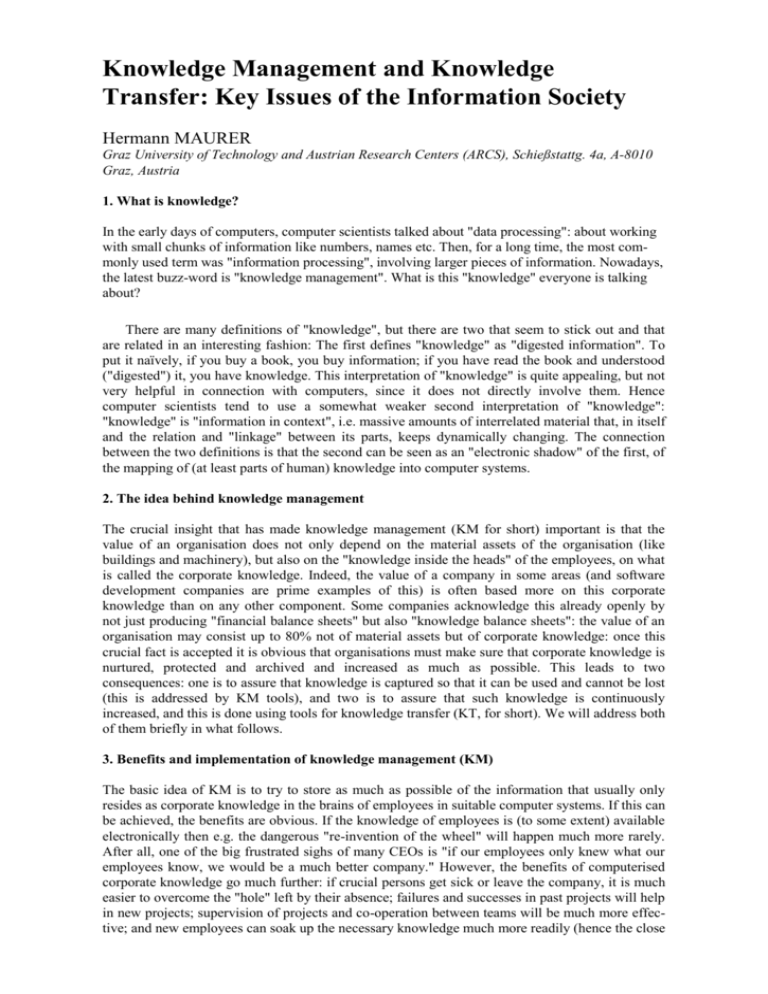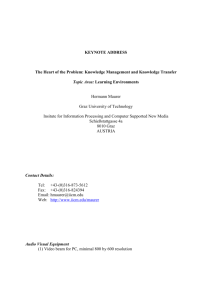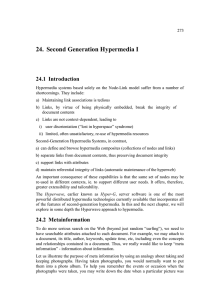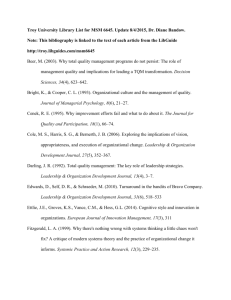Knowledge Management and Knowledge Transfer
advertisement

Knowledge Management and Knowledge Transfer: Key Issues of the Information Society Hermann MAURER Graz University of Technology and Austrian Research Centers (ARCS), Schießstattg. 4a, A-8010 Graz, Austria 1. What is knowledge? In the early days of computers, computer scientists talked about "data processing": about working with small chunks of information like numbers, names etc. Then, for a long time, the most commonly used term was "information processing", involving larger pieces of information. Nowadays, the latest buzz-word is "knowledge management". What is this "knowledge" everyone is talking about? There are many definitions of "knowledge", but there are two that seem to stick out and that are related in an interesting fashion: The first defines "knowledge" as "digested information". To put it naïvely, if you buy a book, you buy information; if you have read the book and understood ("digested") it, you have knowledge. This interpretation of "knowledge" is quite appealing, but not very helpful in connection with computers, since it does not directly involve them. Hence computer scientists tend to use a somewhat weaker second interpretation of "knowledge": "knowledge" is "information in context", i.e. massive amounts of interrelated material that, in itself and the relation and "linkage" between its parts, keeps dynamically changing. The connection between the two definitions is that the second can be seen as an "electronic shadow" of the first, of the mapping of (at least parts of human) knowledge into computer systems. 2. The idea behind knowledge management The crucial insight that has made knowledge management (KM for short) important is that the value of an organisation does not only depend on the material assets of the organisation (like buildings and machinery), but also on the "knowledge inside the heads" of the employees, on what is called the corporate knowledge. Indeed, the value of a company in some areas (and software development companies are prime examples of this) is often based more on this corporate knowledge than on any other component. Some companies acknowledge this already openly by not just producing "financial balance sheets" but also "knowledge balance sheets": the value of an organisation may consist up to 80% not of material assets but of corporate knowledge: once this crucial fact is accepted it is obvious that organisations must make sure that corporate knowledge is nurtured, protected and archived and increased as much as possible. This leads to two consequences: one is to assure that knowledge is captured so that it can be used and cannot be lost (this is addressed by KM tools), and two is to assure that such knowledge is continuously increased, and this is done using tools for knowledge transfer (KT, for short). We will address both of them briefly in what follows. 3. Benefits and implementation of knowledge management (KM) The basic idea of KM is to try to store as much as possible of the information that usually only resides as corporate knowledge in the brains of employees in suitable computer systems. If this can be achieved, the benefits are obvious. If the knowledge of employees is (to some extent) available electronically then e.g. the dangerous "re-invention of the wheel" will happen much more rarely. After all, one of the big frustrated sighs of many CEOs is "if our employees only knew what our employees know, we would be a much better company." However, the benefits of computerised corporate knowledge go much further: if crucial persons get sick or leave the company, it is much easier to overcome the "hole" left by their absence; failures and successes in past projects will help in new projects; supervision of projects and co-operation between teams will be much more effective; and new employees can soak up the necessary knowledge much more readily (hence the close connection between KM and KT!). It is thus one of big challenges of information technology today to provide tools for KM. Are there any KM systems available today? The answer to this is a clear "NO". There are two reasons for this: one is that certain aspects of human knowledge are subtle to the extent that we don't know how to formalise them, i.e. we don't know how we could even create "shadows of such knowledge" in a computer system, to stick to the above mentioned comparison; indeed, it is not clear to what extent we will ever be able to do this completely. The second reason why full knowledge management systems are not only not available, but are actually not even in sight is that to formalise certain knowledge processes, much restructuring of processes will have to take place in the organisations concerned, first. Thus, although there are no full-fledged KM systems, there are indeed systems that allow to handle essential parts of KM. One such system, Hyperwave (see http://www.hyperwave.com) received one of the main IT awards of the commission in 1997. (The interested reader is referred to [1] concerning Hyperwave, and [2], [3] for its role in KM).Hyperwave is a sophisticated system that allows to store and structure large parts of corporate knowledge in a way that makes it accessible to various groups at the level needed. Although Hyperwave cannot cover all of KM, Hyperwave allows to reduce the amount of corporate knowledge that is not available in computerised form dramatically. This is achieved by a seamless combination of the four major information-access paradigms available: searching, structuring, attributing and linking, with sophisticated automatic data-, link- and access-rights management. There is not enough room to go into details, but it is worth noting that using Hyperwave, the structure, tasks, directories etc. of an organisation, work flow and staging mechanisms, quality control procedures, archivable email- and other asynchronous communication facilities can be combined with synchronous communication, with "digital background libraries" (see the EU project LIBERATION at e.g. http://www.iicm.edu/LIBERATION and the presentation under http://wbt.iicm.edu/KM_KT) to indeed capture many important aspects of KM. This is true because Hyperwave allows different views of the same information for different groups, made possible by the definition of arbitrarily many overlapping access structures, the use of access rights and enhanced by notes and links that can be made visible to arbitrary small or large groups of users. 4. The place and role of knowledge transfer (KT) Once a (partial) KM system is in place it should be obvious that a KT system can be easily be placed on top of it. See [4] or [5] for details, or try out the Hyperwave Training Space at http://wbt.iicm.edu/courses after registering there as student (with arbitrary user ID and number). The basic idea of such a system is to have a guided multimedia tour ("courseware") combined with the possibility to consult area specific background libraries, combined with the creation of private or group notes and links, a discussion forum, chat facilities and the possibility to ask questions in a fashion that the question/answer dialogues are made visible to later students. Hyperwave Training Space (as one such system) is currently in prototype use by a number big international organisation and universities with already thousands of users; it will be available as product early in 1999. It is seen as one further module in making Hyperwave a leading platform for KM and KT. 5. Conclusion KM and KT are closely related and a challenge for information technology. Europe, with Hyperwave and a number of Web Based Training and Digital Library projects is at the forefront of research in this area, and could become a dominant player world-wide if resources are pooled around acknowledged successes such as Hyperwave and the emerging Hyperwave Training Space. References [1] Maurer, H. (1997) What We Want from WWW as Distributed Multimedia System. Proc. VSMM’97, Geneva:.IEEE, 148-155. [2] Maurer, H. (1998) Modern WISs. C.ACM, 41, 7: 114-115. [3] Maurer, H. (1998) Web-Based Knowledge Management. Internet Watch, Computer, March 98, IEEE, 122-123 [4] Maurer, H. (1998) Using the WWW System Hyperwave as the Basis of a General Networked Teaching and Learning Environment. CIT vol. 6, 1: 63-72. [5] Maurer, H. (1998) A critical look at current Web Based Training effort. Proc. ICCE98, Beijing: CHEP, Beijing and Springer Heidelberg, 30-33.











